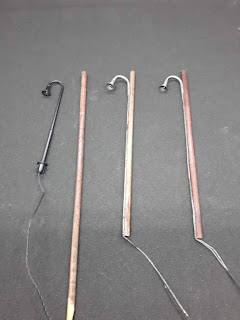It's been a while since I last posted, but things haven't been completely idle on the Salmon Run & Robson Landing Railway or its subsidiary, Salmon Run Lumber Co. Here, in no particular chronological order are the newest developments.
First, an early Christmas present to Salmon Run Lumber, a new diesel engine, Bachmann's Whitcomb 50-ton Center Cab. Here it is with Salmon Run Lumber markings as engine #28, and yes, it has the sound module. BTW, I produce my own decals using a laser printer and blank decal sheets. Does it run well? Oh, yes and it sounds perfect, thanks to twin speakers, one on each end. I was surprised that the entire shell as well as the railings are all metal. That gives it a heft unmatched by any other of my engines, save perhaps my Baldwin 2-8-0, the biggest hauler on the layout. Truly a well-running, attractive addition to the roster.
Then, three new structures, two scratchbuilt, one a kit from the incomparable Bar Mills Models.
First up, I needed a small office shack for the team track at Robson Landing South and designed one to fit the small space available. It is entirely build of wood, except for the Grandt Line windows and door.
Salmon Run Lumber Camp #1 has been without a proper water tower since its inception and the other day, I finally decided to build one using my latest tool, a Proxxon miter saw. It made cutting the dimensional lumber to precise lengths time after time a snap. All is scratchbuilt, even the spout.
Finally, the Bar Mills Models kit, one of two I received last month -- Old Man Harts. I built it as a semi derelict storage building for Salmon Run Lumber Camp #1 and you can see a bit of it to the right of the water tower above. Constructing and weathering it as an unloved, abandoned place taught me new techniques. The hobos using it seem happy that the lumber company men aren't around to roust them.
I placed both the water tower and the storage shed on a sheet of foam core board with a section of track that connects to the rest of the lumber camp, so it is, in effect, a diorama that hosts a working spur. Doing the scenery work on my worktable rather than the layout gave me the chance to really build it up. And since it's not fastened down yet, I can always take that section down and add more until I get to the point of doing the scenery around it. The photos really don't do the depth of field and details justice. I can't think I'd get the same effect in HO, which is part of why I moved to On30.
Up next? The other Bar Mills Models kit I got last month, The Gravely Building. It will be the last of the big buildings because I'm running out of space. But I have a few smaller ones dating back to my first forays into O scale scratchbuilding which need replacing.
Since this is likely my last post of 2021, a very Merry Christmas to all and a Happy New Year. Keep railroading!













